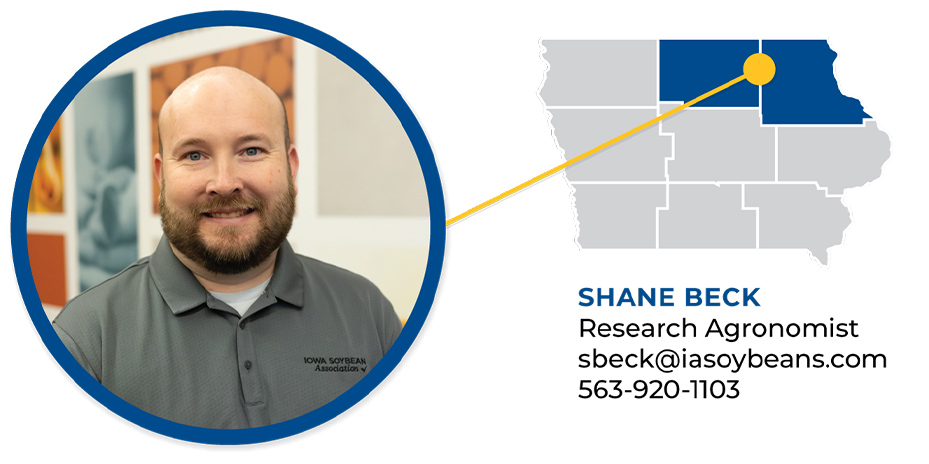
Warm weather this week is pushing soybeans closer to maturity. Corn harvest has begun, and soybean harvest is expected in the next few weeks. (Photo: Iowa Soybean Association / Joclyn Kuboushek)
Walking Rows: Aware of field conditions
September 11, 2025
As combines start rolling across Iowa, farmers are closely watching corn and soybean fields for disease, moisture and yield potential after a wet, unpredictable growing season.
Iowa Soybean Association research agronomists are urging farmers to be aware of field conditions that could be affecting yield in a positive or negative way and note those issues for planning for future growing seasons.
Alex Schaffer - Central/South Central Iowa
Soybean fields that aren't severely affected by sudden death syndrome are changing colors pretty naturally now, and I think there will be a nice harvest ahead. I am still surprised we didn't find a lot of disease in our fungicide trials given the rainy year we've had. We'll see what the results say, but my hunch is once again this year that fungicide applications without disease pressure do not pay, especially when soybean prices are $10.
Combines have already started or are getting very close to rolling in central and southern Iowa. I said in the last edition of Walking Rows that I thought it would be an early corn harvest, as it appears that southern rust really got the best of some fields. It seems like some fields went straight from August conditions to October conditions and skipped September.

Fields that were sprayed with fungicide were not as affected by southern rust, and will see a large test weight advantage this harvest.
My takeaway from a wet year like this one is to pay attention to disease pressure in Arkansas. As the storms are rolling up from the south, they are bringing disease inoculum with them. If you see southern rust pop up in states south not too far from here, it would be a good time to get on your applicator’s spray list. In my opinion, many farmers were late making the call, wasting money on fungicides.
We are encouraging farmers to participate in ISA trials. You can read more about what we have available here.
Shane Beck – Northeast/Northern Iowa
Corn fields are starting to be harvested with soybeans not too far behind. There were several fields that were harvested over the last week in north-central Iowa. I haven’t heard of any yields or the moisture on the corn that was coming out of those fields yet, but I am eager to know how they are doing.
The soybeans are slowly turning. The cool weather last week slowed them down, but the warmer weather this week should help them move along quickly. Most soybeans are still a week or more out from being ready to combine.

The next thing to be thinking about is fall nitrogen applications if that is a part of your system. This fall, we are partnering with Pivot Bio to test their new product called PROVEN G3. With this partnership, we are examining how this product performs with varying rates of anhydrous applied in the fall.
In the fall, we will write a nitrogen prescription with four different rates that will be variable rate applied in strips. Those rates would be the standard rate of the farm, and then an added 20 pounds, minus 20 pounds and minus 40 pounds. In the spring, we will get some of the seed treated with PROVEN G3. There will then be strips of PROVEN G3 and standard seed treatment planted over the different nitrogen rate strips. If this is a trial you would like to participate in, reach out to me or your regional agronomist and we can get you set up for this fall.
Craig Woods – Northwest Iowa
Most soybeans are in R7 growth stage and are dropping leaves as we progress to harvest. Depending on planting date and maturity group, most corn is at the R5 or R6 growth stage with disease pressuring shortening the growth stages.
Harvest speed and priority for soybeans in northwest Iowa will largely be determined by whether lodging occurred due to strong winds and heavy rains throughout the growing season. Corn harvest priority will be dependent on which fields have the most disease pressure or lodging, as diseases can lead to faster changes in moisture and weak stalks.

For those who interseed cover crops using plane or drone, precipitation might be a ways away. While beneficial for harvest, it will slow down the establishment of cover crops, limiting the amount of nutrient scavenging that can occur before conditions turn colder. For those worried that prolonged exposure to no rain will hinder germination, it is unlikely that conditions will be stressful for long enough.
Preparing for soil sampling involves comparing prior and future results. To compare accurately, keep the comparison consistent, as changes can affect the results.
Gathered by Kriss Nelson.
Back